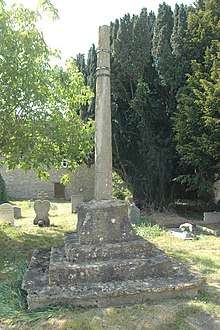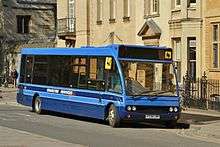Charlton-on-Otmoor
Charlton-on-Otmoor is a village and civil parish about 9 miles (14 km) NE of Oxford and 6 miles (10 km) SW of Bicester in Oxfordshire, England. The village, one of the seven "towns" of Otmoor, dates back to the 11th century and sits on the northern edge of the moor on a ridge of Cornbrash. The 2011 Census recorded the parish's population as 449.[1]
| Charlton-on-Otmoor | |
|---|---|
 St Mary the Virgin parish church | |
 Charlton-on-Otmoor Location within Oxfordshire | |
| Area | 3.31 km2 (1.28 sq mi) |
| Population | 449 (2011 Census) |
| • Density | 136/km2 (350/sq mi) |
| OS grid reference | SP5615 |
| Civil parish |
|
| District |
|
| Shire county | |
| Region | |
| Country | England |
| Sovereign state | United Kingdom |
| Post town | Kidlington |
| Postcode district | OX5 |
| Dialling code | 01865 |
| Police | Thames Valley |
| Fire | Oxfordshire |
| Ambulance | South Central |
| UK Parliament | |
| Website | Charlton on Otmoor Parish Council |
Church and chapels
Church of England
Charlton had a parish church by the 11th century.[2] The present Church of England parish church of Saint Mary the Virgin was a 13th-century Early English Gothic building but there were substantial Decorated Gothic alterations in the 14th century. The east window is slightly later, in the transitional style from Decorated to Perpendicular Gothic. Around the beginning of the 16th century the clerestory and a new roof were added to the nave, and a new window was added to the south aisle.[3]

In the early 16th century the present rood screen and rood loft (for a crucifix between the chancel and nave) were added to the church. During the English Reformation Edward VI's injunctions of 1547 instructed that rood screens and lofts be removed from all churches in England and Wales. Charlton's screen and loft survived these injunctions, and in the 20th century the critic Jennifer Sherwood judged them "the finest and most complete in the county".[4] A tradition of garlanding the rood cross with flowers and box greenery on May Day and carrying it in procession around the parish also survived the Reformation and continues in modern times.[2] In recent years, due to pressure on the school administration, it is usually impossible to hold the May Garland Service on May Day so it is held either in late April or later in May.
In 1846 the Gothic Revival architect G. E. Street re-roofed the church and restored the north wall. In 1889 the rood screen and loft were restored.[2] St Mary's has never been over-restored, and its Decorated and Perpendicular mediaeval character has survived almost intact.
By 1553 the bell tower had five bells[2] plus a Sanctus bell, but all have since been recast or replaced.[5] Richard Keene, whose foundries included one at Woodstock,[6] cast the two largest bells in 1681.[7] Thomas Lester of the Whitechapel Bell Foundry[6] cast another bell in 1746[7] and Matthew II Bagley of Chacombe, Northamptonshire cast another in 1755. The then treble bell broke in 1789[5] but John Warner and Sons of the Whitechapel Bell Foundry recast it that same year.[7] In the 19th century the Bagley bell survived for a long time with a fracture, but in 1895 its tongue and head fell out.[5] Mears and Stainbank of the Whitechapel Bell Foundry replaced or recast the broken bell in 1898.[7] In 1998 the Whitechapel Bell Foundry cast a new treble bell,[7] making the 1789 bell the second bell and increasing the tower to a ring of six bells. In 1999 the new bell was hung and the old bells re-hung as a project for the village to celebrate the Millennium.[5] John Warner and Sons cast the present Sanctus bell in 1793.[7]
St Mary's church clock is of unknown date but appears to be late 17th century.[8] Two of the wheels of the going train are characteristic of the work of the clockmaker and bellfounder Edward Hemins of Bicester, which would make them an early-18th-century alteration.[8]
St Mary's is now part of the Church of England Benefice of the Ray Valley.[9]
Baptist and Methodist chapels
Charlton-on-Otmoor had a Baptist meeting house by 1810 and a chapel in 1835. The village also had a Methodist congregation by 1829 and a chapel in 1840. The Methodist chapel had ceased to be used by the end of the 19th century and was sold to the rector in 1920 for use as a club room.[2] The Baptist chapel closed around 2010 and was later sold and converted to a residential property.
Amenities
Primary school
The enclosure of 1858 set aside land for the building of a school and in 1866 Charlton Parochial School and a master's house were built, mostly at the expense of the rector. The number of pupils grew and a second classroom was added in 1892. It was reorganised as a junior school in 1937 and became a voluntary controlled school in 1951.[2] It is now Charlton-on-Otmoor Church of England Primary School with over 100 children attending the school and pre-school.[11]
Public houses
The George and Dragon was where locals formed the Otmoor Association in 1830, leading to the Otmoor Riots in opposition to plans to drain and enclose Otmoor. The rioters achieved their objective, and the villagers continued to farm a four-field open field system. A subsequent attempt at enclosure in 1858 was successful.[2] The George and Dragon closed around 1980 but The Crown remains and has been trading for over 100 years.
Sports clubs
The village has a football team Charlton United Football Club which plays in Oxfordshire Senior Football League Division One.
Local groups
The Otmoor branch of the WI meets monthly at Charlton-on-Otmoor Community Hall.
Parish newsletter
The parish newsletter for Charlton-on-Otmoor, Oddington, Fencott and Murcott is The Otmoor Review.
Transport
Bus

The first regular bus service on Otmoor was started in the 1920s and after a change of ownership in the 1950s was renamed Charlton Services.[12] The company continues to this day providing Charlton-on-Otmoor and neighbouring villages with services to Bicester and Oxford via Arncott and Islip.[13] Their buses in the familiar Forget Me Not blue livery appeared in a number of episodes of ITV's Inspector Morse television series.
Railway
The Buckinghamshire Railway between Bletchley and Oxford passes through Charlton parish and was completed in 1851. The London and North Western Railway took it over in 1879 and opened Charlton Halt, 1 mile (1.6 km) north of the village, in 1905. The 1923 Grouping made the L&NWR part of the new London, Midland and Scottish Railway, which closed Charlton Halt in 1926. The LMS was nationalised as part of British Railways in 1948, which ended passenger services in 1967 and reduced the line to single track. Oxfordshire County Council arranged for British Rail to reopen the line in 1987 and Islip station in 1988. From 2014 to 2016 Network Rail rebuilt the railway as an 100 mph (160 km/h) main line linked to the Chiltern Main Line by a junction at Bicester. The nearest railway station is Islip, 3 miles (5 km) from Charlton. It is served by Chiltern Railways with direct trains to London Marylebone via Bicester Village and Oxford via Oxford Parkway.
References
- "Area: Charlton-on-Otmoor (Parish): Key Figures for 2011 Census: Key Statistics". Neighbourhood Statistics. Office for National Statistics. Retrieved 10 November 2015.
- Lobel 1959, pp. 80–92.
- Sherwood & Pevsner 1974, pp. 529–530.
- Sherwood & Pevsner 1974, p. 530.
- "Charlton-on-Otmoor". Oxford Diocesan Guild of Church Bell Ringers, Bicester Branch. Archived from the original on 13 August 2011. Retrieved 9 September 2011.
- Baldwin, Sid (7 September 2011). "Bell Founders". Dove's Guide for Church Bell Ringers. Central Council of Church Bell Ringers. Retrieved 9 September 2011.
- Baldwin, John (10 March 2005). "Charlton on Otmoor S Mary V". Dove's Guide for Church Bell Ringers. Central Council of Church Bell Ringers. Retrieved 9 September 2011.
- Beeson & Simcock 1989, pp. 33–34.
- Archbishops' Council (2010). "Benefice of the Ray Valley". A Church Near You. Church of England. Archived from the original on 16 January 2016. Retrieved 9 September 2011.
- Crossley 1983, pp. 81–120.
- Charlton-on-Otmoor CE Primary School Archived 11 September 2009 at the Wayback Machine
- "Charlton-on-Otmoor Services Ltd". Vehicle Operator Licensing. Archived from the original on 22 March 2019. Retrieved 22 March 2019.
- "94 - Oxford - Islip - Ambrosden". Bus Times. Archived from the original on 22 March 2019. Retrieved 22 March 2019.
Sources and further reading
- Beeson, CFC; Simcock, AV (1989) [1962]. Clockmaking in Oxfordshire 1400–1850 (3rd ed.). Oxford: Museum of the History of Science. pp. 33–34. ISBN 0-903364-06-9.CS1 maint: ref=harv (link)
- Crossley, Alan (ed.); Baggs, AP; Colvin, Christina; Colvin, HM; Cooper, Janet; Day, CJ; Selwyn, Nesta; Tomkinson, A (1983). A History of the County of Oxford. Victoria County History. 11: Wootton Hundred (northern part). London: Oxford University Press for the Institute of Historical Research. pp. 81–120. ISBN 978-0-19722-758-9.CS1 maint: extra text: authors list (link) CS1 maint: ref=harv (link)
- Jackson, Christine (2008). "Thomas Garth, Rector of Charlton-on-Otmoor, 1615–1643: Rake or Reformer?" (PDF). Oxoniensia. Oxfordshire Architectural and Historical Society. LXXIII: 45–58. ISSN 0308-5562.CS1 maint: ref=harv (link)
- Lobel, Mary D, ed. (1959). A History of the County of Oxford. Victoria County History. 6: Ploughley Hundred. London: Oxford University Press for the Institute of Historical Research. pp. 80–92.CS1 maint: ref=harv (link)
- Sherwood, Jennifer; Pevsner, Nikolaus (1974). Oxfordshire. The Buildings of England. Harmondsworth: Penguin Books. pp. 529–530. ISBN 0-14-071045-0.CS1 maint: ref=harv (link)
